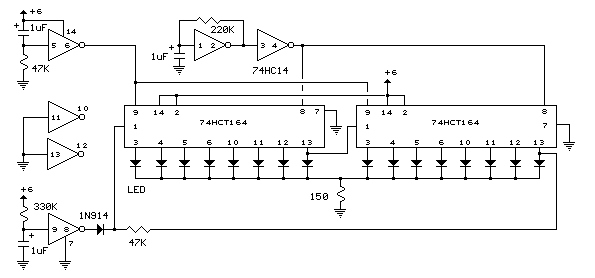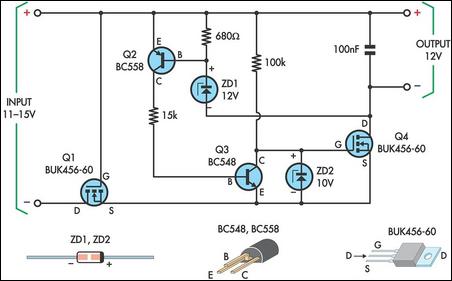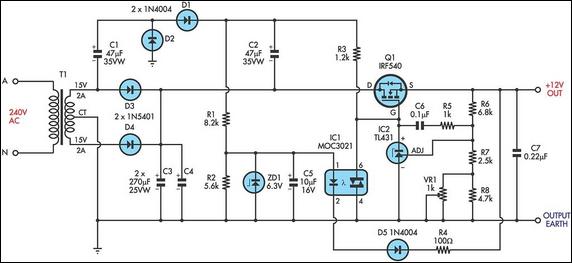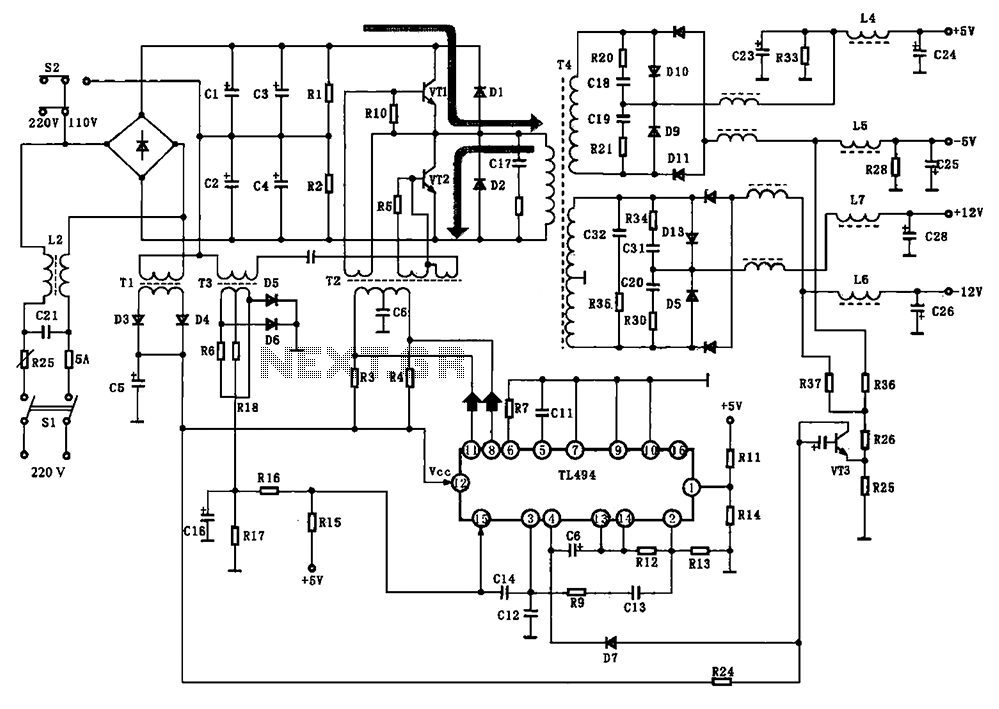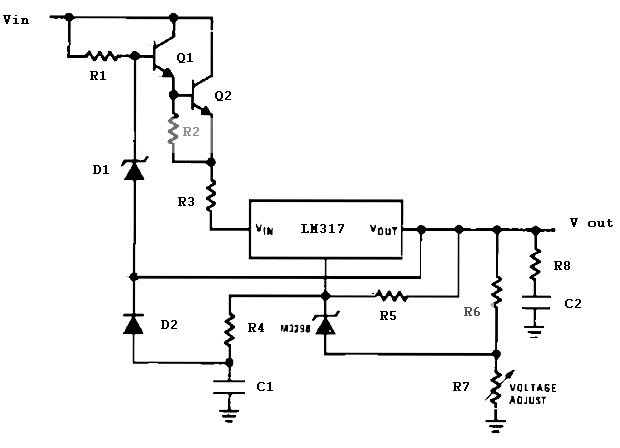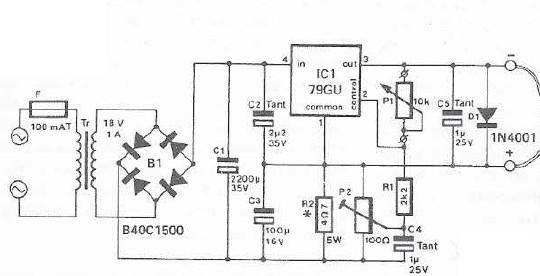
Few Switching regulator circuits
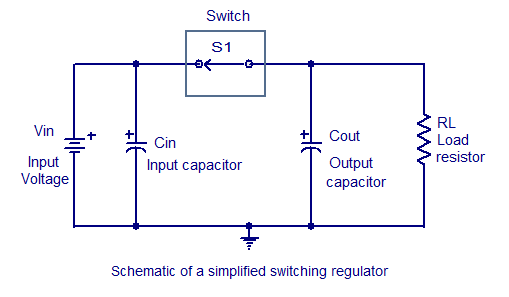
Switching regulators operate by drawing small amounts of energy from the input source and transferring it incrementally to the output. This is achieved using an electronic switch, which functions at a predetermined frequency, acting as a gate between the input energy source and the output. The switch regulates the amount of charge transferred to the output load. The output voltage of the switching regulator is influenced by the duration the switch remains closed; a longer OFF time results in less energy being transferred, leading to a lower average output voltage, while a shorter OFF time allows for more energy transfer, resulting in a higher average output voltage. In a basic switching regulator schematic, when switch S1 is closed, capacitor Cout is charged, and when S1 is open, Cout discharges through the load. The duty cycle of S1 determines the energy transferred to the output load. Essentially, Cout acts as a filter that converts the pulse waveform from the switch into a steady voltage. The output voltage is always a function of the input voltage and the switch's duty cycle. In a practical switching regulator circuit, additional components such as a Schottky diode D1 and an inductor L1 are included, significantly enhancing circuit performance. When S1 is closed, inductor L1 resists the rising current by creating an opposing electromagnetic field, causing diode D1 to become reverse biased and function like an open switch. When S1 opens, the electromagnetic field in L1 discharges, generating current in the reverse polarity, which forward biases D1, keeping it conducting until the field in L1 dissipates. This action resembles the charging and discharging of the output capacitor, thereby improving the filtering capability of Cout and enhancing circuit efficiency. The uA78S40 IC from On Semiconductor is utilized in two switching voltage regulator circuits: a step-down converter and an inverting converter. The uA78S40 is an integrated switching regulator capable of various applications, featuring built-in voltage reference circuitry with temperature compensation, an oscillator with duty cycle control, a high-capacity switching element, an independent operational amplifier, and a diode. For voltages exceeding 40V or output currents above 1.5A, external switching transistors are required. The uA78S40 has a wide temperature range, adjustable output voltage (1.5V to 40V), peak output current of 1.5A, 80dB load regulation, 80dB line regulation, and a broad supply voltage range (2.5V to 40V), along with very low standby current. Its applications include step-up converters, step-down converters, and inverting converters. The uA78S40 is available in a 16-pin DIP plastic package. The switching step-down converter circuit using uA78S40 allows for an input voltage of 25V DC and an output voltage of 5V at 500mA. Ct serves as the timing capacitor for the internal oscillator, while C3 functions as the input filter capacitor, rated above 25V, and C2 can be rated higher than 10V. The instantaneous output voltage across output capacitor Cc is fed back to the inverting input of the internal op-amp through a resistor network comprising R1 and R2.
Switching regulators are essential components in power management applications, providing an efficient means of converting and regulating voltage levels. The operation relies on the principles of energy storage and transfer, where inductors and capacitors work together to minimize ripple and maintain a stable output voltage. The duty cycle, defined as the ratio of the ON time to the total cycle time, is critical in determining the output voltage. By adjusting the duty cycle, the regulator can effectively manage the energy supplied to the load, catering to varying demands.
The inclusion of a Schottky diode in the circuit is particularly advantageous due to its low forward voltage drop and fast switching capabilities, which reduce power losses and improve efficiency. The inductor's role in storing energy during the ON phase and releasing it during the OFF phase is crucial for maintaining output stability. The feedback mechanism involving resistors R1 and R2 ensures that the output voltage remains within the desired range, compensating for any variations in input voltage or load conditions.
The uA78S40's versatility and performance make it suitable for various applications, including battery-powered devices, automotive systems, and industrial equipment, where efficient voltage regulation is paramount. The design of the circuit must consider component ratings and thermal management to ensure reliable operation under varying conditions. Overall, switching regulators like those utilizing the uA78S40 IC play a vital role in modern electronic systems, balancing efficiency, performance, and adaptability.Switching regulators work by drawing small amounts of energy from the input source and transferring it step by step to the output. This task is attained by using an electronic switch (operating at a predetermined frequency) which works like a gate between the input energy source and the output.
This gate controls the amount of charge that is trans ferred to the output load. The output voltage of the switching regulator depends on how much time the switch is maintained closed. If the OFF time of switch is long then less energy will be transferred to the output load and so the average output voltage will a be low.
If the OFF time of switch is short then more energy will be transferred to the output load which results in a better average output voltage. The schematic of a basic switching regulator is shown below. When switch S1 is closed capacitor Cout is charged and when switch S1 is open the Cout discharges through the load.
The duty cycle of the S1 determines how much energy is transferred to the output load. In simple words the capacitor Cout serves as a filter which converts the pulse waveform from the switch in to a steady voltage. The output voltage will be always a function of the input voltage and the duty cycle of the switch. The schematic of a practical switching regulator is shown above. This circuit has two additional components, a Schottky diode D1 and an inductor L1. These two components are present in almost all switching regulator circuits and they drastically improves the performance of the circuit.
Let us see how the diode and inductor improves the performance of the regulator circuit. When switch S1 is closed the inductor L1 opposes the rising current by creating an opposing electromagnetic field and this makes the diode D1 reverse biased and it behaves like an open switch. When switch S1 is made open the electromagnetic field that was induced in the inductor L1 will be discharging and this creates a current in the reverse polarity.
This makes the diode D1 forward biased and it will remain in the conducting stage until the field in the inductor becomes zero. In simple words this action is similar to the charging and discharging of the output capacitor. Thus the combined effect of the inductor and diode improves the filtering capability of the output capacitor and so the circuit efficiency is improved.
Here are two switching voltage regulator circuits using uA78S40 IC from On Semiconductors. The first one is a step down converter while the second one is an inverting converter. uA78S40 is a switching regulator IC that can be used for a variety of applications. The uA78S40 is an integrated switching regulator circuit which has built in circuitries for voltage reference with temperature compensation, oscillator with duty cycle control, high capacity switching element, an independent operational amplifier and independent diode. When voltages excess of 40V or output currents excess of 1. 5A are required external switching transistors must be used. The features of uA78S40 include wide temperature range, adjustable output voltage (from 1. 5V to 40V), peak output current of 1. 5A, 80dB load regulation, 80dB line regulation, wide supply voltage range ( from 2. 5V to 40V), very low standby current etc. The applications of this IC include step up converters, step down converters, inverting converters etc.
The uA78S40 is available in a 16 pin DIP plastic package. The circuit shown above is of a switching step down converter using uA78S40. The input voltage can be 25V DC and the output voltage is 5V @500mA. Ct is the timing capacitor for the internal oscillator while C3 is the input filter capacitor. C3 must be rated above 25V while C2 can be rated anything higher than 10V. The instantaneous output voltage (that is the voltage across output capacitor Cc) is fed back to the inverting input of the internal opamp using the resistor network comprising of R1 and R2. 🔗 External reference
Switching regulators are essential components in power management applications, providing an efficient means of converting and regulating voltage levels. The operation relies on the principles of energy storage and transfer, where inductors and capacitors work together to minimize ripple and maintain a stable output voltage. The duty cycle, defined as the ratio of the ON time to the total cycle time, is critical in determining the output voltage. By adjusting the duty cycle, the regulator can effectively manage the energy supplied to the load, catering to varying demands.
The inclusion of a Schottky diode in the circuit is particularly advantageous due to its low forward voltage drop and fast switching capabilities, which reduce power losses and improve efficiency. The inductor's role in storing energy during the ON phase and releasing it during the OFF phase is crucial for maintaining output stability. The feedback mechanism involving resistors R1 and R2 ensures that the output voltage remains within the desired range, compensating for any variations in input voltage or load conditions.
The uA78S40's versatility and performance make it suitable for various applications, including battery-powered devices, automotive systems, and industrial equipment, where efficient voltage regulation is paramount. The design of the circuit must consider component ratings and thermal management to ensure reliable operation under varying conditions. Overall, switching regulators like those utilizing the uA78S40 IC play a vital role in modern electronic systems, balancing efficiency, performance, and adaptability.Switching regulators work by drawing small amounts of energy from the input source and transferring it step by step to the output. This task is attained by using an electronic switch (operating at a predetermined frequency) which works like a gate between the input energy source and the output.
This gate controls the amount of charge that is trans ferred to the output load. The output voltage of the switching regulator depends on how much time the switch is maintained closed. If the OFF time of switch is long then less energy will be transferred to the output load and so the average output voltage will a be low.
If the OFF time of switch is short then more energy will be transferred to the output load which results in a better average output voltage. The schematic of a basic switching regulator is shown below. When switch S1 is closed capacitor Cout is charged and when switch S1 is open the Cout discharges through the load.
The duty cycle of the S1 determines how much energy is transferred to the output load. In simple words the capacitor Cout serves as a filter which converts the pulse waveform from the switch in to a steady voltage. The output voltage will be always a function of the input voltage and the duty cycle of the switch. The schematic of a practical switching regulator is shown above. This circuit has two additional components, a Schottky diode D1 and an inductor L1. These two components are present in almost all switching regulator circuits and they drastically improves the performance of the circuit.
Let us see how the diode and inductor improves the performance of the regulator circuit. When switch S1 is closed the inductor L1 opposes the rising current by creating an opposing electromagnetic field and this makes the diode D1 reverse biased and it behaves like an open switch. When switch S1 is made open the electromagnetic field that was induced in the inductor L1 will be discharging and this creates a current in the reverse polarity.
This makes the diode D1 forward biased and it will remain in the conducting stage until the field in the inductor becomes zero. In simple words this action is similar to the charging and discharging of the output capacitor. Thus the combined effect of the inductor and diode improves the filtering capability of the output capacitor and so the circuit efficiency is improved.
Here are two switching voltage regulator circuits using uA78S40 IC from On Semiconductors. The first one is a step down converter while the second one is an inverting converter. uA78S40 is a switching regulator IC that can be used for a variety of applications. The uA78S40 is an integrated switching regulator circuit which has built in circuitries for voltage reference with temperature compensation, oscillator with duty cycle control, high capacity switching element, an independent operational amplifier and independent diode. When voltages excess of 40V or output currents excess of 1. 5A are required external switching transistors must be used. The features of uA78S40 include wide temperature range, adjustable output voltage (from 1. 5V to 40V), peak output current of 1. 5A, 80dB load regulation, 80dB line regulation, wide supply voltage range ( from 2. 5V to 40V), very low standby current etc. The applications of this IC include step up converters, step down converters, inverting converters etc.
The uA78S40 is available in a 16 pin DIP plastic package. The circuit shown above is of a switching step down converter using uA78S40. The input voltage can be 25V DC and the output voltage is 5V @500mA. Ct is the timing capacitor for the internal oscillator while C3 is the input filter capacitor. C3 must be rated above 25V while C2 can be rated anything higher than 10V. The instantaneous output voltage (that is the voltage across output capacitor Cc) is fed back to the inverting input of the internal opamp using the resistor network comprising of R1 and R2. 🔗 External reference
